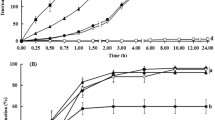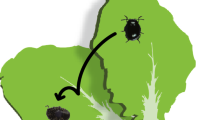Abstract
The rates of hypocotyl and radicle survival and of germination success were investigated in mature acorns ofQuercus variabilis Blume in relation to endosperm loss due to seed insects. The acorns were damaged by curculio weevils (Coleoptera: Curculionidae) and moths, including tortricid moths (Lepidoptera: Tortricidae); the former were more abundant than the latter. Acorns damaged by curculio weevils showed a significantly lower germination rate when there was a large endosperm loss than the rate for sound acorns. The survival rate of the hypocotyl and radicle also decreased as endosperm loss increased. These results suggest that acorn germination is directly inhibited by damage to the hypocotyl and radicle, which depends on the amount of endosperm eaten by the weevils. However, the germination rate of acorns with hypocotyl and radicle was consistently high, irrespective of the degree of endosperm loss, which suggests that weevil-damaged acorns probably germinate, provided the hypocotyl and radicle survive until the cessation of damage.
Similar content being viewed by others
Literature cited
Fujii, S. (1993) Studies on acorn production and seed predation inQuercus serrata: Growth, falling phenology, estimation of production, and insect seed predators. Bull. Osaka Mus. Nat. Hist. 47: 1–17.
Fukumoto, H. and Kajimura, H. (1999) Seed-insect fauna of pre-dispersal acorns and acorn seasonal fall patterns ofQuercus variabilis andQ. serrata in central Japan. Entomol. Sci. 2: 197–203.
Kanazawa, Y. (1975) Production, dispersal and germination of acorns in natural stands ofQuercus crispula: A preliminary report. J. Jpn. For. Soc. 57: 209–214.
Kanazawa, Y. and Nishikata, S. (1976) Disappearance of acorns from the floor inQuercus crispula forests. J. Jpn. For. Soc. 58: 52–56.
Kaushal, B. R. and Kalia, S. (1989) The effects ofDicranognathus nebulosus (Coleoptera: Attelabidae) on acorns ofQuercus leucotrichophora. Ecol. Entomol. 14: 239–241.
Kikuzawa, K. (1988) Dispersal ofQuercus mongolica acorns in a broadleaved deciduous forest 1. Disappearance. For. Ecol. Manage. 25: 1–8.
Maeto, K. (1993) Acorn insects ofQuercus mongolica var.grosseserrata in Hitsujigaoka natural forest, Hokkaido: Life-history of the principal species and their impacts on seed viability. Trans. Mtg. Hokkaido Br. Jpn. For. Soc. 41: 88–90. (in Japanese)
Maeto, K. (1995) Relationships between size and mortality ofQuercus mongolica var.grosseserrata acorns due to pre-dispersal infestation by frugivorous insects. J. Jpn. For. Soc. 77: 213–219.
Matsuda, K. (1982) Studies on the early phase of the regeneration of a konara oak (Quercus serrata Thunb.) secondary forest I. Development and premature abscissions of konara oak acorns. Jpn. J. Ecol. 32: 293–302.
Miyaki, M. and Kikuzawa, K. (1988) Dispersal ofQuercus mongolica acorns in a broadleaved deciduous forest 2. Scatterhoarding by mice. For. Ecol. Manage. 25: 9–16.
National Astronomical Observatory (1994) Chronological scientific tables. 1042pp, Maruzen, Tokyo. (in Japanese)
Oliver, A. D. and Chapin, J. B. (1984)Curculio fulvus (Coleoptera: Curculionidae) and its effects on acorns of live oaks,Quercus virginiana Miller. Environ. Entomol. 13: 1507–1510.
Steele, M. A., Knowles, T., Bridle, K., and Simms, E. L. (1993) Tannins and partial consumption of acorns: Implications for dispersal of oaks by seed predators. Am. Midl. Nat. 130: 229–238.
Ueda, A., Igarashi, M., Ito, K., and Koizumi, T. (1992) Acorn infestation by insects on three evergreen oaks,Quercus glauca, Q. myrsinaefolia andPasania edulis (I) Their invasion term and level before acorn dropping and comparison with the deciduousQ. serrata. Trans. 103rd Meet. Jpn. For. Soc.: 529–532. (in Japanese)
Weckerly, F. W., Sugg, D. W., and Semlitsch, R. D. (1989) Germination success of acorns (Quercus): Insect predation and tannins. Can. J. For. Res. 19: 811–815.
Author information
Authors and Affiliations
Additional information
Research Fellow of the Japan Society for the Promotion of Science.
This study was supported in part by Grants-in-Aid for Scientific Research from the Japan Ministry of Education, Science and Culture (No. 09001647, No. 10660144, and No. 11460068) and the Nippon Life Insurance Foundation.
About this article
Cite this article
Fukumoto, H., Kajimura, H. Effects of insect predation on hypocotyl survival and germination success of maturequercus variabilis acorns. J For Res 5, 31–34 (2000). https://doi.org/10.1007/BF02762760
Accepted:
Issue Date:
DOI: https://doi.org/10.1007/BF02762760




